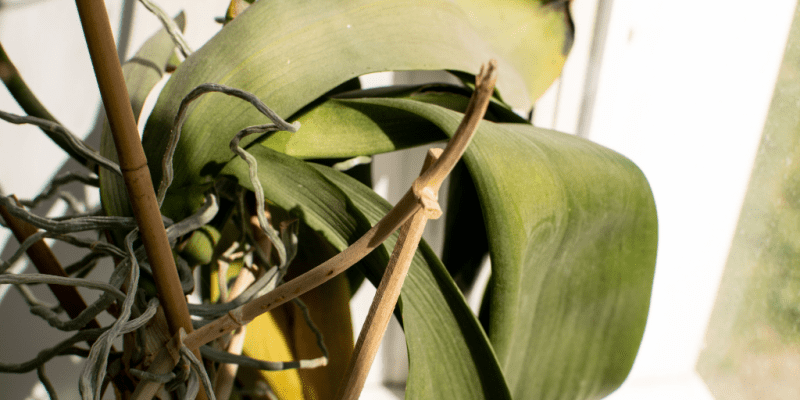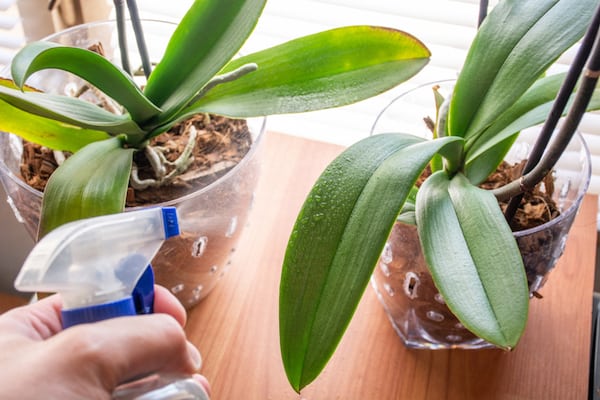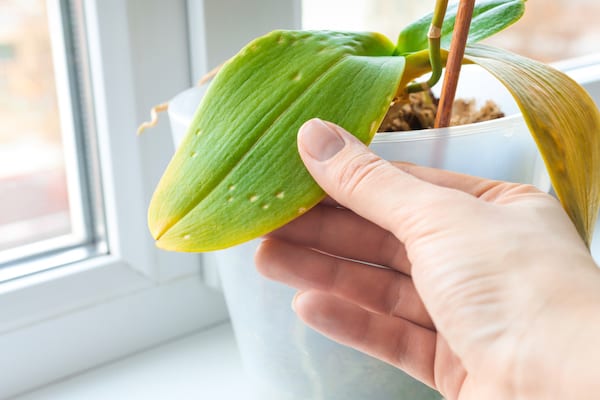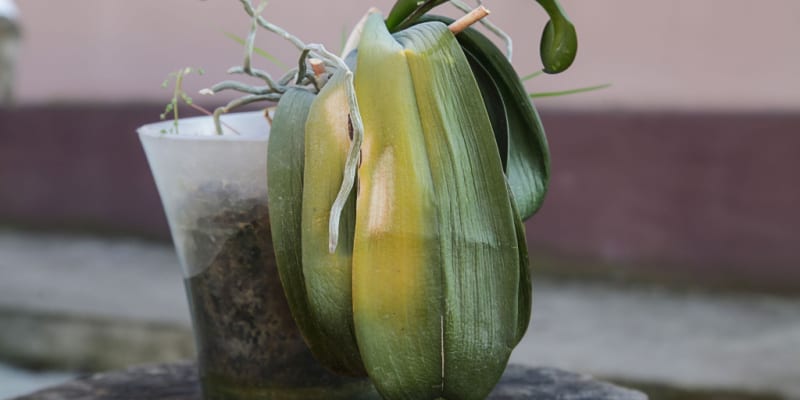
Why is my orchid wilting?
Our site is reader supported, this means we may earn a small commission from Amazon and other affiliates when you buy through links on our site.
The two main reasons for your orchid wilting are water and heat – either an excess or shortage of each. Plus transplant shock from repotting your orchid plant can lead to its leaves wilting. Read on to determine which problem is plaguing your orchid and what to do about it.
Water and moisture
Over- and under-watering can both cause wilting
Both over-watering and under-watering your orchid have the same effect on the plant. The leaves turn yellow, become wrinkled and wilt. But the roots look different in each case so that helps you narrow down which one is causing your plant its leaf problem.
Over-watering orchids
Giving the plant too much water causes the roots to become saturated and unable to take in oxygen and ‘breathe’. The roots turn brown and squishy and become the ideal home for the fungal disease of root rot. The roots are unable to transport water and nutrients up to the plant. The leaves then turn yellow and brown and wilt in order to conserve what little water they do receive.
Under-watering
Not giving the plant enough water has the same effect on the leaves. In this case the roots turn brown and dry up, once again being unable to circulate water and nutrients to the plant. This results in drought stress for the plant and the flowers also dry up.
What to do
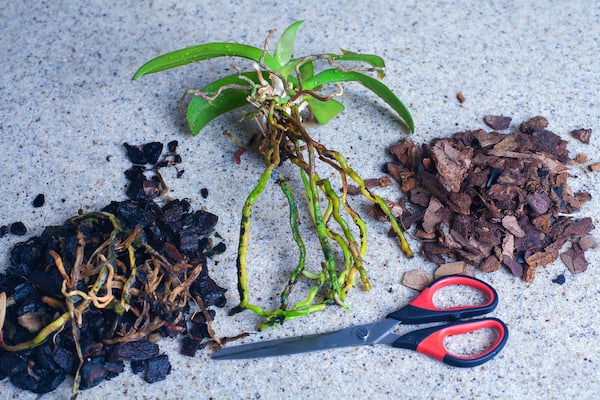
If you’ve overwatered your orchid, remove the diseased or soggy roots by cutting them away and let the other roots dry out fully. Add more drainage holes to your orchid pot and check the potting soil. Be careful you are not putting your orchid pot into another decorative pot that doesn’t have holes and letting water collect in the bottom.
For an under-watering problem, mist the orchid lightly with a water spray and adjust your watering schedule.
In both cases, change your watering schedule. The rule of thumb is to water the plant when the top of the potting mix dries out. But my guide, When and how to water my orchid, gives the details on the ins and outs of watering your orchid plant for its best growth. See also the guide Should I water my orchid with ice cubes? for a new way of keeping your plant moist.
Too little humidity
Orchids originate from the tropical rainforest so they’re used to a fairly humid environment. Orchid experts say that the surrounding air for these plants should have at least 40% humidity. Chances are that your home isn’t this humid, especially in the winter with the central heating turned on.
Dry environments dry out the plant and can cause the leaves to wilt from lack of moisture.
What to do
You can mist the plant frequently with water mist from a small spray bottle. Or make up a tray with pebbles or gravel on it to stand the orchid pot on. Pour some water over the pebbles but not enough that the water touches the bottom of the plant pot. (It will be taken up by the potting mix through the drainage holes and throw off your careful watering plan.) This creates a moist atmosphere around the plant as long as you remember to keep the water in the tray topped up.
Heat
Orchids evolved in a warm tropical environment. But even so, if they’re exposed to temperatures outside the range they’re used to, you find your orchids wilting. Depending on the orchid type, the temperatures they prefer vary. But it’s usually in the range of 12˚C to 23˚C. I have had this issue when growing orchids in a greenhouse when the summer tempatures just got to hot.
Be aware though, that the night-time temperatures need to be a good 5˚C cooler than the daytime temperatures to give the orchid a cooling resting period. (Lower temperatures also encourage the plant to rebloom.)
Having too hot or cold a temperature, or with no difference in the night and day temperatures results in the orchid wilting, both the leaves and the flowers.
What to do
Be mindful of the day and night temperatures of where you place your orchid. Make sure it’s out of any breezes or chills. The heat around it has to come from indirect sunlight as direct sunshine can burn the flowers and leaves, turning them yellow and brown, drying them up and making the orchid plant wilt.
Potting mix and drainage
Specialist orchid potting mix lets the roots of the orchid grow freely. It also drains quickly through the many drainage holes in the orchid pot. Regular potting soil is too heavy and compact and squeezes the roots, stopping them from transporting water and feed to the plant. Orchids have roots that grow in air so you must cater to that.
The two key words in potting an orchid are drainage and aeration. A lack of either – that is, too much water and not enough air circulation in the roots – causes harm to the plant and can end in the orchid wilting.
What to do
Use only potting mix for orchids for your orchid plants. My article Do orchids need special soil? details what’s in such a mix and helps you create your own if you don’t want to buy a ready-made mix.
Even if you have a special orchid mix, check the amount of ingredients it has that hold onto water, such as permeable clay and moss. These may keep the water to themselves and cause the entire potting mix to become waterlogged. Remove some of these ingredients if the potting mix seems too wet.
And check the drainage holes in your orchid pot. Many pots have holes down the side as well as in the base to ensure the maximum drainage of excess water from the plant’s immediate environment. Make sure the holes aren’t plugged by the potting mix.
Also keep track of how long it’s been since you last repotted your plant and completely changed out the potting medium. The medium does decompose and lose nutrients. It also becomes less aerated over time, causing the orchid to wilt. Orchid growers suggest repotting your orchid every two years, especially if the roots have grown bigger.
Transplant and repot
Transplanting or repotting your orchid can be a stressful time for it, no matter how careful and considerate you are. Transplant shock may set in as the orchid has to adapt to changes in its environment, even if that’s just brand new orchid potting mix. You find your orchid wilting as it gathers enough strength to get used to its new conditions and go on as before.
What to do
When and how to repot an orchid is my article with instructions on the best way to approach putting your orchid in a new container. It starts by discussing the signs that you need to repot your plant so you can tell if it’s time.
You may want to review How to grow and care for orchids to double check that your orchid (in its new pot) is placed in the best conditions for its continued successful growth.
If you have issues with orchids not flowering, check out this guide now.
